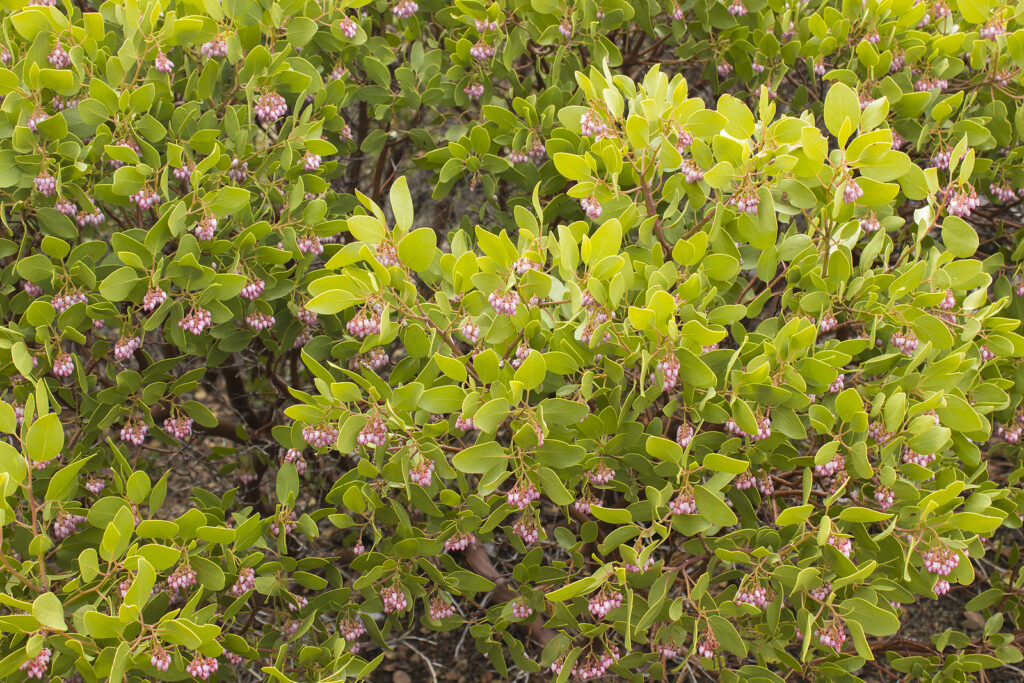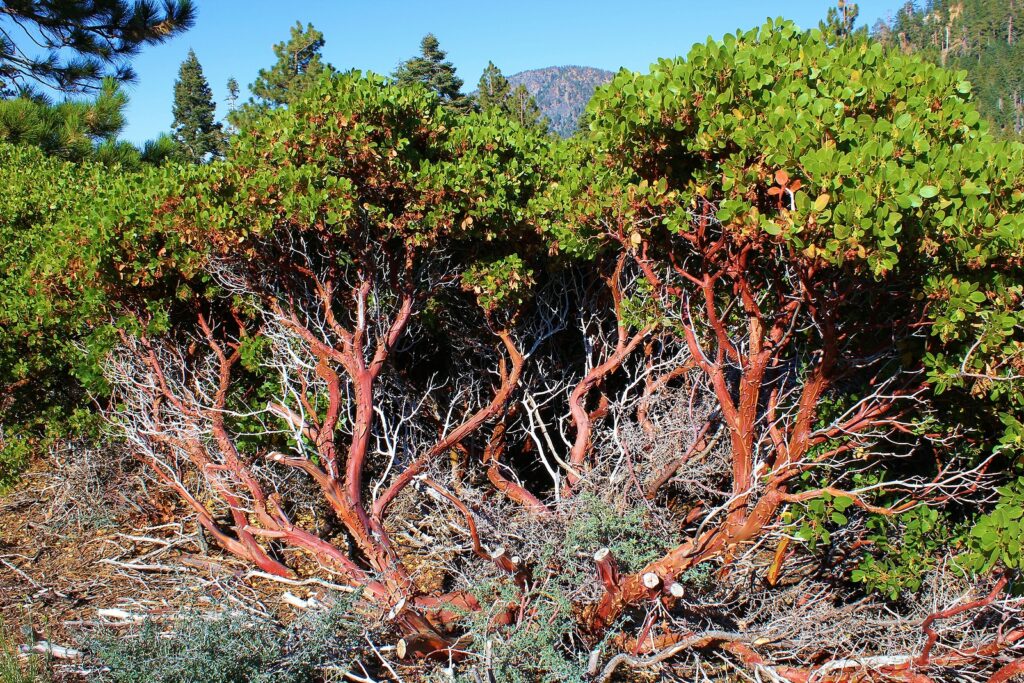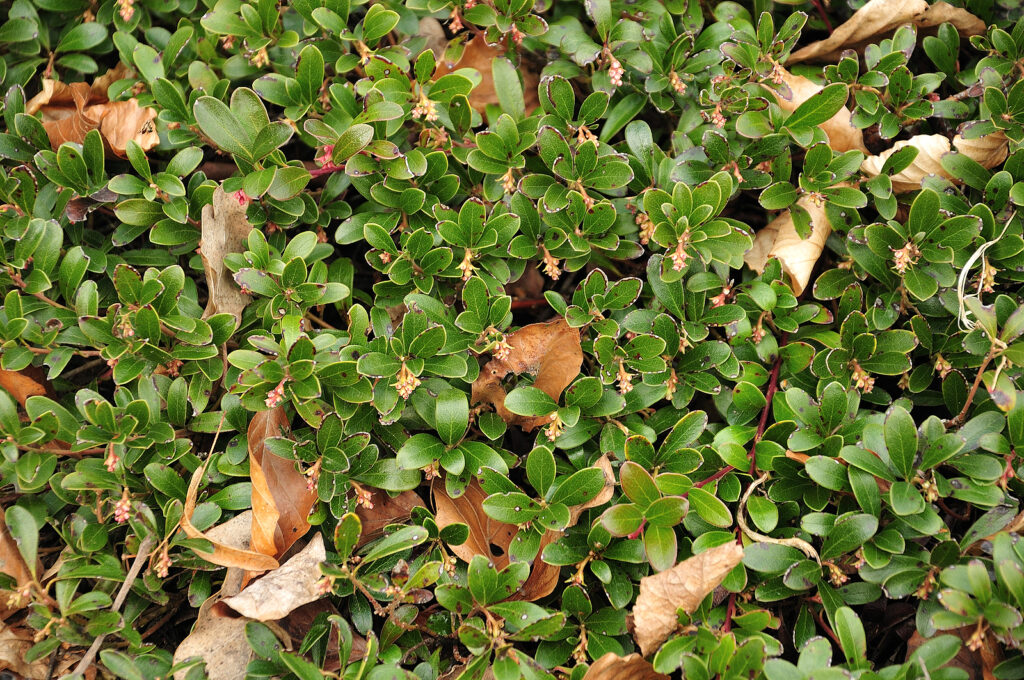Arctostaphylos, commonly called manzanita, are mostly evergreen shrubs and small trees. They have lustrous green leaves and bear small, urn-shaped flowers and attractive berries. There are low-growing, ground-hugging species suited as ground covers and there are large shrubby varieties that can be used as informal hedges or windbreaks.
Arctostaphylos are well-suited for challenging sites. They wilI grow in poor, dry, sandy soil ranging from, acid to alkaline, in sun or shade, and tolerate salt and wind. Once established Arctostaphylos are drought-tolerant,
Arctostaphylos is a genus of about 50 species of mostly evergreen shrubs or small trees, primarily from western North America, especially California.

Get to know Arctostaphylos
- Plant type: Evergreen shrubs
- Growing zones and range: Zones 7 to 10
- Hardiness: Hardy to Zone 7
- Height and width: Size varies with variety from ground-hugging spcies to large, tree-size species.
- Foliage: Leathery, glossy green leaves are alternate with smooth or toothed edges
- Flowers: Small white or pink urn-shaped flowers borne of termianl panicles or racemes
- Bloom time: Late winter to early spring,
- Fruit: Berrylike red or brown spherical fruits.
- Uses: Groundcover, informal shrub borders, open areas, woodland gardens
- Common name: Manzanita, bearberries
- Botanical name: Arctostaphylos
- Family name: Ericaceae
- Origin: Western North America, particularly California
Where to plant Arctostaphylos
- Plant Arctostaphylos in full sun or light shade.
- Arctostaphylos requires excellent drainage but can tolerate poor soil, preferring rocky or sandy, acid soils to heavy, rich ones.
- Arctostaphylos does not like humidity or boggy soil.
When to plant Arctostaphylos
- Set contianer-grown Arctostphylos in the garden in spring or autumn. Autumn planting after rainfall will help plants become established.

Planting and spacing Arctostaphylos
- Space large varieties 10 feet (3m) apart.
- Plant Arctostaphylos intended as ground covers from quart-sized containers, spaced a foot apart.
- Arctostaphylos can be difficult to establish. Start shrubs in autumn after a good rain.
How to water and feed Arctostaphylos
- Arctostaphylos needs only moderate water. Once established Arctostaphylos is drought tolerant.
- Fertilize Arctostaphylos in spring with an organic, slow-release fertilizer.
Arctostaphylos care
- Pruning Arctostaphylos shrub tips lightly will encourage growth. Do not prune prostrate branches.
Arctostaphylos pests and diseases
- Bud and leaf galls are common on Arctostaphylos.
- Arctostaphylos is susceptibe to a variety of fungal diseases on leaves, stems, and fruit.

Arctostaphylos propagation
- Sow seed in containers in a cold frame in autumn; immerse seeds in boiling water for 20 seconds before sowing.
- Start semi ripe cuttings in summer.
- Layer branches in fall; prostrate species and hybrids often root at the nodes.

Arctostaphylos varieties to grow
- Arctostaphylos columbiana. Hairy manzanita. Compact, low-growing shrub with reddish bark; gray-green leaves to 3 inches long; white flowers, and red-cheeked fruit; one cultivar is called ‘Oregon Hybrid’.
- A. densiflora. Vine hill manzanita. Low and spreading shrub; outer branches root where they touch the soil; main stems slender and crooked. Reddish black, smooth bark with small glossy green leaves; white or pink flowers. Cultivar ‘Howard McMinn’ grows 5 to 6 feet tall and 7 feet wide; ‘Harmony’ is similar but taller and broader. ‘Sentinel’ is upright to 6 feet tall or taller, spreading to 8 feet wide.
- A. ‘Emerald Carpet’. Dense, uniform mounding carpet shrub 9 to 14 inches tall; tiny, oval bright green leaves; small pink flowers are not showy.
- A. hookeri. Monterey manzanita. Dense mounding shrub 1 ½ to 4 feet tall spreading to 6 feet wide or more; small glossy green leaves, white to pinkish flowers, shiny bright red fruit, smooth red-brown bark. Cultivar ‘Monterey Carpet’ is 1 foot tall, spreading by rooting branches to 12 feet wide. ‘Wayside’ grows 4 feet tall and 8 feet or more wide.
- A. manzanita. Common manzanita. Grows 6 to 20 feet tall and 4 to 10 feet wide. Crooked branching habit; purplish-red bark; small, broadly oval leaves; white to pink flowers in drooping clusters; fruit white, turns deep red. ‘Dr. Hurd’ is a treelike form to 15 feet tall and as wide or wider, with mahogany bark, large light green leaves, and white flowers.
- A. uva-ursi. Bearberry, kinnikinnick. Prostrate, spreading, and rooting ground cover shrub grows to 2 feet tall eventually making broad mats a few inches deep; small, glossy, leathery leaves are bright green, turning red or purplish in winter; white or pinkish flowers are followed by red or pink fruits. Slow to become established. Good ground or bank cover at seashore, in mountains.
- ‘Alaska’. Flat grower with small, round dark green leaves.
- ‘Emerald Carpet’ has pink flowers and tolerates shade.
- ‘Massachusetts’. Small leafed, flat growing bears bundant pinkish-white flowers, red fruit.
- ‘Point Reyes’. Dark green leaves closely set along branches is fairly tolerant of heat and drought.
- ‘Radiant’. Leaves lighter green and more widely spaced than those of ‘Point Reyes’. Heavy crop of large bright red fruit appears in fall, lasts into winter.
- ‘Vancouver Jade’ has pink flowers and strong autumn color.
- ‘Wood’s Red’. Small dark green leaves turn reddish in cold weather bears large bright red berries.















